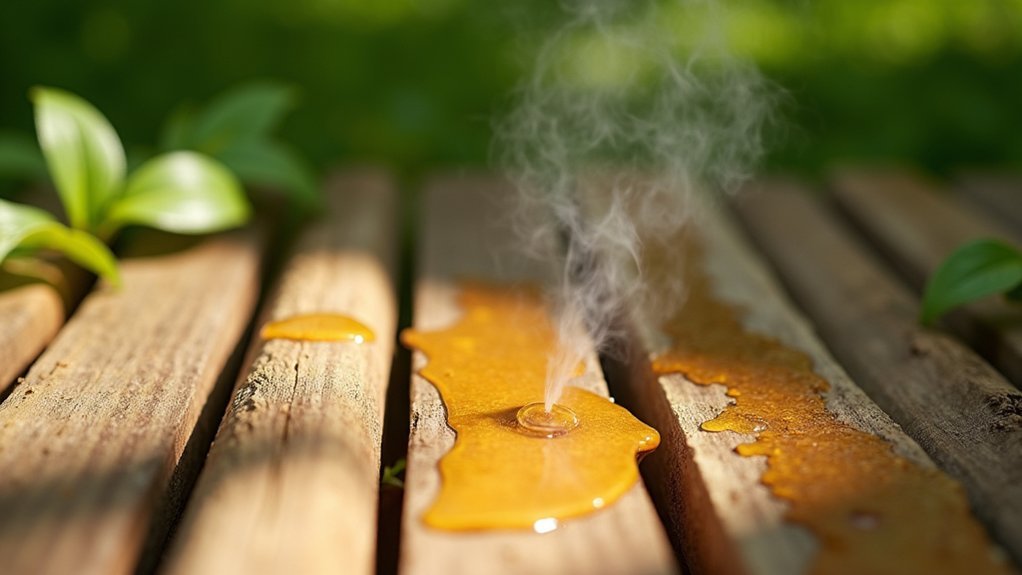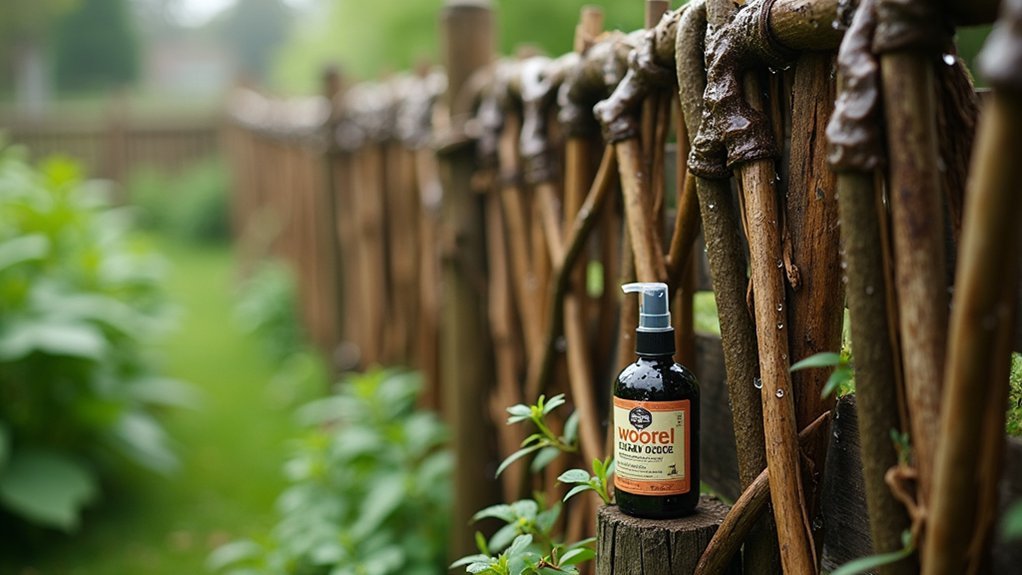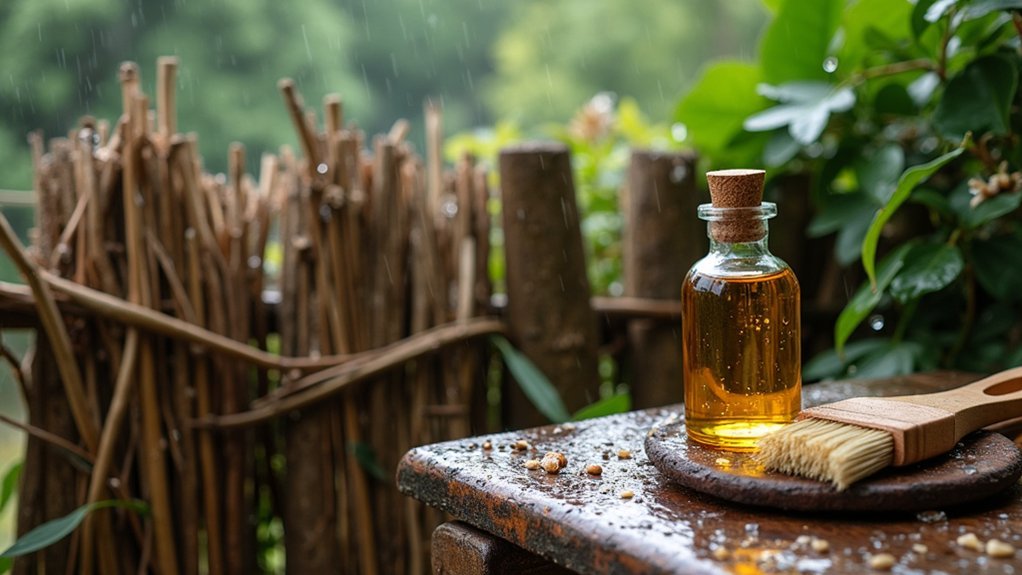To weatherproof your willow fence effectively, you’ll need a combination of treatments and practices. Apply a boiled linseed oil and turpentine mixture twice yearly, use spray sealants for quick coverage, incorporate natural oils and waxes, consider professional-grade coatings, clean regularly, position strategically away from harsh elements, and follow a seasonal treatment schedule. These seven methods work together to protect against moisture, UV damage, and environmental wear. Proper implementation will dramatically extend your fence’s lifespan and beauty.
Applying Boiled Linseed Oil and Turpentine Mixture

When protecting your willow fence against the elements, a mixture of equal parts boiled linseed oil and turpentine creates an effective barrier.
Combine these ingredients in a clean pot before application for best weatherproofing results.
Use a brush to generously coat both sides of your fence, ensuring thorough coverage. This treatment should be reapplied once or twice yearly to maintain your fence’s integrity and prevent brittleness, greatly extending its lifespan.
Apply treatment to both fence sides annually to preserve integrity and prevent damage, extending your willow fence’s life considerably.
Be cautious of the mixture’s sticky texture, which can persist for up to two weeks after application. Avoid contact with other surfaces during this period.
Always follow safety precautions when working with boiled linseed oil and turpentine, including proper disposal of soaked rags to prevent spontaneous combustion.
Using Spray Sealants for Quick Protection
Although brushing provides thorough coverage, spray sealants offer a faster and more efficient alternative for weatherproofing your willow fence.
Using a spray bottle with a mixture of turpentine and boiled linseed oil (slightly more turpentine than oil) creates an effective waterproofing sealant that requires less product while ensuring even distribution.
When applying your spray sealant:
- Mix thoroughly and spray both sides of your fence for complete protection
- Expect a sticky texture that will last 1-2 weeks as the treatment sets
- Perform regular inspections, looking for silver/grey coloring or exposed bark that indicates it’s time to reapply
This spray application method efficiently protects your willow from moisture and UV damage, greatly enhancing its lifespan.
You’ll appreciate the time saved while still providing essential weather protection for your fence.
Natural Oils and Waxes for Eco-Friendly Preservation

For homeowners seeking a more natural approach to fence preservation, oils and waxes offer excellent eco-friendly alternatives to chemical treatments. Boiled linseed oil penetrates willow fibers deeply, providing essential moisture protection while enhancing the natural beauty of your fencing.
Waxes like beeswax and carnauba create an effective water-repellent barrier that prevents moisture absorption and reduces rot risk. Both natural oils and waxes shield against harmful UV rays that cause premature aging and weathering.
To maximize your willow fence’s lifespan, apply these preservatives thoroughly to all surfaces twice yearly. Untreated panels quickly become brittle and deteriorate, while those protected with natural oils and waxes maintain their flexibility and appearance for years.
This simple maintenance routine offers substantial protection while keeping your garden space chemical-free.
Professional-Grade Waterproof Coatings
Professional-grade waterproof coatings like acrylic-latex sealants offer your willow fence superior protection against moisture, UV damage, and cracking for up to four years.
You’ll find clear formulations that preserve the natural beauty of willow while providing essential weatherproofing benefits.
For best results, clean and dry your fence thoroughly before using an airless paint sprayer to guarantee even coverage and maximum protection.
Premium Sealant Options
The highest quality protection for willow fences comes from premium waterproofing sealants that penetrate deep into the wood fibers. Products like Olympic Maximum Clear Waterproofing Sealant deliver up to four years of defense against water damage, UV deterioration, and mildew growth while enhancing your fence’s natural beauty.
When selecting premium sealant options, consider:
- Weather-ready formulations that allow you to clean and seal in the same day
- Semi-transparent varieties that add color while maintaining waterproofing properties
- Professional-grade products compatible with airless paint sprayers for ideal coverage
You’ll achieve the best results by applying these premium sealants with professional equipment, ensuring the coating reaches every part of your willow fence.
This investment in quality materials provides superior long-term protection against the elements while preserving your fence’s aesthetic appeal.
Application Best Practices
Applying professional-grade waterproof coatings correctly will greatly extend your willow fence’s lifespan while preserving its natural appeal.
For ideal results, thoroughly clean and dry the surface before application to guarantee proper adhesion of products like Olympic Maximum Clear Waterproofing Sealant.
When applying the waterproof coating, use a professional-grade airless paint sprayer, maintaining 12-18 inches of distance from the fence surface for even coverage.
Don’t delay protection—apply your sealant within 6-8 weeks after installation for peak effectiveness.
To maintain your fence’s beauty and durability, implement these application best practices: conduct regular inspections and reapply waterproofing every 4 years.
This simple maintenance schedule considerably extends the life of your willow fencing while protecting against water damage, UV rays, and mildew.
Regular Cleaning and Maintenance Practices

Regular removal of debris from your willow fence prevents moisture buildup that leads to rot and structural weakening.
You’ll need to brush away leaves, dirt, and plant material from both sides of the panels, paying special attention to areas where sections overlap.
Treating any signs of mold or algae immediately with a gentle vinegar solution will maintain the fence’s integrity and extend its lifespan in damp environments.
Debris Removal Techniques
Maintaining your willow fence’s longevity requires three essential cleaning practices to prevent decay and structural damage. Your debris removal techniques should be thorough and consistent to prevent moisture retention that leads to wood rot.
- Use a soft brush or pressure washer to remove mold and algae buildup, preserving both appearance and structural integrity of your fence.
- Reach high areas with a ladder to guarantee all sections of tall privacy fences are properly cleared, allowing for even drying.
- Clean your fence every few months, removing accumulated leaves and organic materials before they can trap moisture.
Always verify the fence is completely dry before applying any waterproof treatments or sealants, as this maximizes their effectiveness and extends your willow fence’s lifespan.
Mold Prevention Strategies
Three essential strategies will protect your willow fence from mold damage throughout the seasons.
First, regularly inspect and remove accumulated organic debris like leaves and dirt, which trap moisture and create ideal conditions for mold growth.
Second, implement a thorough cleaning schedule, washing your fence at least twice yearly with a power washer or scrub brush to eliminate existing mold, algae, and dirt.
Always guarantee the fence dries completely before applying any treatments.
Finally, create a protective barrier by applying a mixture of boiled linseed oil and turpentine up to twice annually.
For enhanced protection, consider using a specialized mold-resistant sealant designed specifically for wooden structures.
These mold prevention strategies not only protect your fence from unsightly growth but also considerably extend its lifespan and maintain its aesthetic appeal.
Strategic Positioning and Environmental Shields
The strategic positioning of your willow fence can substantially extend its lifespan, even before applying any protective treatments.
By carefully considering your fence’s location, you’ll minimize exposure to harsh elements that accelerate deterioration.
Smart positioning is your fence’s first defense against nature’s relentless weathering assault.
- Place your fence away from areas with strong wind tunnels or where heavy rain consistently hits with force, creating a strategic positioning that naturally protects the willow material.
- Elevate the fence base slightly (1-2 inches) above ground level to prevent moisture wicking and subsequent rot development.
- Use existing landscape features like hedges, shrubs, or trees as natural windbreaks and weather shields for your fence.
Ensure proper drainage around your fence perimeter and regularly trim overhanging branches that could damage your fence during storms or high winds.
Seasonal Treatment Schedule for Maximum Durability

While many homeowners treat their willow fences sporadically, establishing a consistent seasonal schedule dramatically improves longevity and appearance.
For maximum durability, apply a mixture of boiled linseed oil and turpentine twice yearly—once in early spring and again in late fall.
These strategic timing points guarantee your fence is protected before summer’s intense UV exposure and winter’s harsh moisture.
Use a brush for controlled application or switch to a spray bottle for larger areas, which typically requires less solution overall.
Remember to thoroughly coat both sides of the fencing for complete protection.
Between these scheduled treatments, regularly inspect your fence.
If you notice sections turning silver/grey or bark beginning to show, don’t wait—apply an additional treatment to maintain continuous protection throughout the year.
Frequently Asked Questions
How to Preserve Willow Fencing?
Preserve your willow fencing by treating it with a mixture of boiled linseed oil and turpentine. Apply it once or twice yearly using a brush or spray bottle. Don’t ignore silver/grey coloring—it needs immediate attention.
What Is the Best Way to Waterproof a Fence?
For ideal waterproofing, you’ll want to apply a mixture of boiled linseed oil and turpentine to your fence. Use a brush for even coverage or a spray bottle for hard-to-reach areas. Reapply twice yearly.
What Is the Best Moisture Barrier for a Fence?
For your fence’s moisture barrier, you’ll want to use a waterproof sealant like boiled linseed oil mixed with turpentine. Apply it once or twice yearly on both sides to prevent water damage and brittleness.
Is It Better to Stain or Seal a Fence?
Both staining and sealing have benefits. You’ll get color options with stain while maintaining wood texture. For maximum weather protection, you can’t beat a sealant. Consider combining them—stain first, then seal for best results.
In Summary
You’ll find that weatherproofing your willow fence isn’t just about applying protective treatments—it’s about creating a thorough care system. Whether you’ve chosen natural oils, professional sealants, or strategic positioning, regular maintenance remains your strongest ally. By combining these seven methods and staying consistent with your seasonal treatment schedule, you’ll extend your fence’s lifespan considerably while preserving its natural beauty through all weather conditions.





Leave a Reply